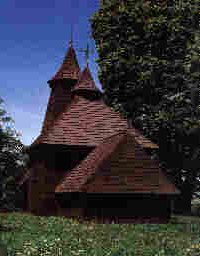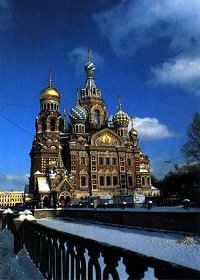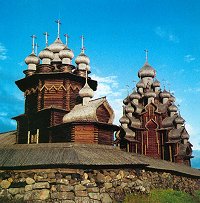|
The pre-Christian Slavs shared much of their religion in its major
aspects with that of the other Indo-European peoples. Their gods derived
from common origins and displayed characteristics in unity with the
other Indo-European religions. The very word for a god (bog)
came from the Iranian language. The Slavic religion was unaccompanied
by doctrinal systems or creeds or scriptures and as a consequence it
evolved in various directions as the ancient Slavic tribes migrated
from their common homeland into Eastern and Southern Europe. Like the other Indo-European peoples the Slavs shared a hierarchy of
gods and spirits, some benevolent and others malevolent, which governed
every aspect of their lives and sought propitiation requiring the expenditure
of much effort through private and public worship and ritual. Paramount
in the ancient Slavic pantheon was Svetovid, god of fertility and war,
who shared his primacy with Svarog, god of heaven and the air. The latter's
son, Svarozid, was god of fire. The two in relationship and function
resembled Zeus and Hephaestus in ancient Greek mythology. Among the
Eastern Slavs Perun, the god of thunder and lightning, enjoyed high
rank like Thor in Germanic mythology. After the Eastern Slavs were converted
to Christianity Perun was eventually absorbed into the personage of
St. Elijah seen in Russian iconography riding a chariot of fire across
the heavens. Important also were Chernobog, the black god of the underworld,
who survives in many Slavic curses, and Belobog, the white god of the
upperworld. The two displayed that dichotomy of good and evil found
everywhere in Indo-European religions, which manifested itself later
in the growth of the Gnostic heretical sects in the early Christian
period. In addition to the above dieties there were many spirits of lesser
importance whose characteristics and functions came to vary considerably
among the various Slavic tribes. They inhabited animals, plants, trees,
rocks and rivers and placed great demands on the ancient Slavs who sought
to propitiate them. Ancient Slavic religion was quite unsophisticated and naturalistic.
It contained neither doctrines nor creeds nor scripture nor organized
priesthood. Above all it was like all other Indo-European religions
in being completely non-ethical, demanding of the people no system of
specific conduct deemed to be pleasing to the dieties. Its practice
was completely ritualistic, i.e. it provided the people with a system
of rites for the propitiation of the gods whether good or bad. That
system of elaborate rites and sacrifices in private shrines was sometimes
accompanied in public temples by human sacrifices and exercised a firm
hold on the Slavs long after they were converted to Christianity. The pre-Christian Slavs were not literate and left no written records
about their culture and religion. Return
to Index.
|



 Among them was the "unclean spirit" (Nechysta Syla) relevant especially
to this web page in supporting the custom among Eastern Slavs to place
healing willow branches behind icons and crosses to augment the latters'
ability to repel evil from the household. One dare not forget the infamous
Baba Yaga who lived in darkness and devoured people. This demonized
goddess or witch is well known in Russian folklore and verse and is
commonly used to frighten children into obeying their parents. Baba
Yage bears a striking similarity to Kanahora, the evil eye of the Eastern
European or Ashkenazi Jews.
Among them was the "unclean spirit" (Nechysta Syla) relevant especially
to this web page in supporting the custom among Eastern Slavs to place
healing willow branches behind icons and crosses to augment the latters'
ability to repel evil from the household. One dare not forget the infamous
Baba Yaga who lived in darkness and devoured people. This demonized
goddess or witch is well known in Russian folklore and verse and is
commonly used to frighten children into obeying their parents. Baba
Yage bears a striking similarity to Kanahora, the evil eye of the Eastern
European or Ashkenazi Jews. What
we know about the pre-Christian Slavic religion, other than that from
analysis of archeological finds, came from the West in the writings
of German missionaries bearing Roman Christianity and from the South
from Greek monks bearing Byzantine Christianity. Both the Eastern and
the Western churches held to the belief that Slavic heathenism was of
demonic origin and entirely without merit. When Christian missionaries
encountered the Slavs they found religious practices entirely different
from their own. Christianity contained a fullness of doctrines and creeds
as well as customs or religious practices derived from and supporting
the fundamentals of the faith. Moreover Christianity had an ethical
system of behavior derived from the religion and illustrated through
scripture and other writings. In other words, Christianity was both
doctrinal and ethical. Slavic religion was neither. As elsewhere when
paganism encountered Christianity it resisted but the old religion was
eventually overcome by the new which incorporated into it some of the
old right into modern times. This subject will be covered more fully
in the essay which follows dealing with the conversion of the Slavs.
What
we know about the pre-Christian Slavic religion, other than that from
analysis of archeological finds, came from the West in the writings
of German missionaries bearing Roman Christianity and from the South
from Greek monks bearing Byzantine Christianity. Both the Eastern and
the Western churches held to the belief that Slavic heathenism was of
demonic origin and entirely without merit. When Christian missionaries
encountered the Slavs they found religious practices entirely different
from their own. Christianity contained a fullness of doctrines and creeds
as well as customs or religious practices derived from and supporting
the fundamentals of the faith. Moreover Christianity had an ethical
system of behavior derived from the religion and illustrated through
scripture and other writings. In other words, Christianity was both
doctrinal and ethical. Slavic religion was neither. As elsewhere when
paganism encountered Christianity it resisted but the old religion was
eventually overcome by the new which incorporated into it some of the
old right into modern times. This subject will be covered more fully
in the essay which follows dealing with the conversion of the Slavs.